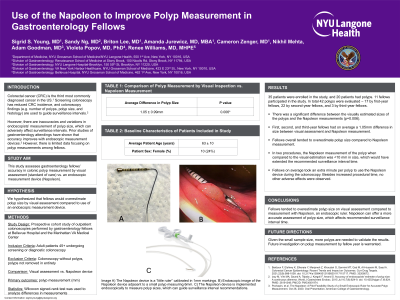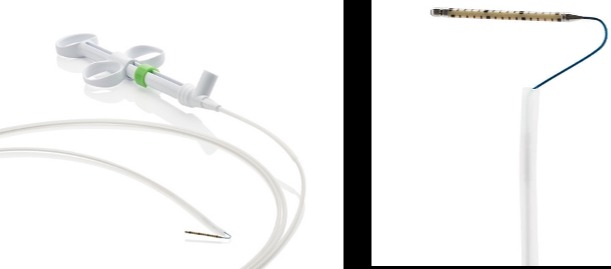Tuesday Poster Session
Category: Colorectal Cancer Prevention
P3184 - Use of the Napoleon to Improve Polyp Measurement in Gastroenterology Fellows
Tuesday, October 24, 2023
10:30 AM - 4:00 PM PT
Location: Exhibit Hall

Has Audio

Sigrid Young, MD
NYU Langone Health
New York, NY
Presenting Author(s)
Sigrid Young, MD1, Sandy Ng, MD2, Briton Lee, MD1, Amanda Jurewicz, MD, MBA3, Cameron Zenger, MD1, Nikhil Mehta, 1, Adam J. Goodman, MD1, Violeta Popov, MD, PhD, FACG1, Renee Williams, MD, FACG1
1NYU Langone Health, New York, NY; 2Stony Brook School of Medicine, Stony Brook, NY; 3University of Pennsylvania Health System, Philadelphia, PA
Introduction: Colorectal cancer (CRC) is the third most commonly diagnosed cancer in the US. Screening by colonoscopy has reduced CRC incidence, and colonoscopy findings (polyp number, size, and histology) are used to guide recommendations for surveillance. However, there are inaccuracies in endoscopists’ measurement of polyp size, which can adversely affect surveillance intervals. Prior studies of gastroenterology attendings have shown that accuracy improves with greater years of experience and endoscopic measurement devices. However, there is limited data on polyp measurements among fellows. This study assesses gastroenterology fellows’ accuracy in colonic polyp measurement by visual assessment (standard of care) versus an endoscopic measurement device (Napoleon).
Methods: This device trial utilized Micro-Tech’s Endoscopic Polyp Measurement Device (Ann Arbor, MI) named Napoleon, which is a catheter with a 15mm ruler, to measure polyp size. This study included inpatient and outpatient colonoscopies performed by gastroenterology fellows at two urban facilities from June 2021 to May 2023. We assessed the difference in polyp measurement between fellows performing a visual assessment and utilization of the Napoleon device, which provides a direct measurement of polyp size. Wilcoxon signed-rank test was used to analyze the differences in measurements.
Results: Eleven fellows participated in the study. In total, 42 polyps were evaluated across 35 patients. 17 polyps were assessed by first-year fellows, 22 by second-year fellows, and 3 by third-year fellows. There was a significant difference between visual estimation of the polyps and Napoleon measurements (p = 0.006). First, second, and third-year fellows had on average a 1.05mm difference in size between visual assessment and Napoleon measurement. Fellows tended to overestimate polyp size compared to Napoleon measurement. In two procedures, the Napoleon polyp measurement was < 10mm in size, which would have extended recommended surveillance time. Fellows on average took an extra minute per polyp to use the Napoleon device. Besides increased procedural time, no other adverse effects were observed.
Discussion: Fellows tended to overestimate polyp size on visual assessment compared to measurement with Napoleon, an endoscopic ruler. Napoleon can offer a more accurate assessment of polyp size, which affects recommended surveillance interval time. Given the small sample size, more polyps are still needed to validate the above results.

Disclosures:
Sigrid Young, MD1, Sandy Ng, MD2, Briton Lee, MD1, Amanda Jurewicz, MD, MBA3, Cameron Zenger, MD1, Nikhil Mehta, 1, Adam J. Goodman, MD1, Violeta Popov, MD, PhD, FACG1, Renee Williams, MD, FACG1. P3184 - Use of the Napoleon to Improve Polyp Measurement in Gastroenterology Fellows, ACG 2023 Annual Scientific Meeting Abstracts. Vancouver, BC, Canada: American College of Gastroenterology.
1NYU Langone Health, New York, NY; 2Stony Brook School of Medicine, Stony Brook, NY; 3University of Pennsylvania Health System, Philadelphia, PA
Introduction: Colorectal cancer (CRC) is the third most commonly diagnosed cancer in the US. Screening by colonoscopy has reduced CRC incidence, and colonoscopy findings (polyp number, size, and histology) are used to guide recommendations for surveillance. However, there are inaccuracies in endoscopists’ measurement of polyp size, which can adversely affect surveillance intervals. Prior studies of gastroenterology attendings have shown that accuracy improves with greater years of experience and endoscopic measurement devices. However, there is limited data on polyp measurements among fellows. This study assesses gastroenterology fellows’ accuracy in colonic polyp measurement by visual assessment (standard of care) versus an endoscopic measurement device (Napoleon).
Methods: This device trial utilized Micro-Tech’s Endoscopic Polyp Measurement Device (Ann Arbor, MI) named Napoleon, which is a catheter with a 15mm ruler, to measure polyp size. This study included inpatient and outpatient colonoscopies performed by gastroenterology fellows at two urban facilities from June 2021 to May 2023. We assessed the difference in polyp measurement between fellows performing a visual assessment and utilization of the Napoleon device, which provides a direct measurement of polyp size. Wilcoxon signed-rank test was used to analyze the differences in measurements.
Results: Eleven fellows participated in the study. In total, 42 polyps were evaluated across 35 patients. 17 polyps were assessed by first-year fellows, 22 by second-year fellows, and 3 by third-year fellows. There was a significant difference between visual estimation of the polyps and Napoleon measurements (p = 0.006). First, second, and third-year fellows had on average a 1.05mm difference in size between visual assessment and Napoleon measurement. Fellows tended to overestimate polyp size compared to Napoleon measurement. In two procedures, the Napoleon polyp measurement was < 10mm in size, which would have extended recommended surveillance time. Fellows on average took an extra minute per polyp to use the Napoleon device. Besides increased procedural time, no other adverse effects were observed.
Discussion: Fellows tended to overestimate polyp size on visual assessment compared to measurement with Napoleon, an endoscopic ruler. Napoleon can offer a more accurate assessment of polyp size, which affects recommended surveillance interval time. Given the small sample size, more polyps are still needed to validate the above results.

Figure: The Napoleon device is a “little ruler” to endoscopically measure polyp size.
Disclosures:
Sigrid Young indicated no relevant financial relationships.
Sandy Ng indicated no relevant financial relationships.
Briton Lee indicated no relevant financial relationships.
Amanda Jurewicz indicated no relevant financial relationships.
Cameron Zenger indicated no relevant financial relationships.
Nikhil Mehta indicated no relevant financial relationships.
Adam Goodman: Ambu, Inc – Consultant. Boston Scientific – Consultant.
Violeta Popov indicated no relevant financial relationships.
Renee Williams: Boston Scientific – Stock-publicly held company(excluding mutual/index funds). Universal Dx – Advisory Committee/Board Member.
Sigrid Young, MD1, Sandy Ng, MD2, Briton Lee, MD1, Amanda Jurewicz, MD, MBA3, Cameron Zenger, MD1, Nikhil Mehta, 1, Adam J. Goodman, MD1, Violeta Popov, MD, PhD, FACG1, Renee Williams, MD, FACG1. P3184 - Use of the Napoleon to Improve Polyp Measurement in Gastroenterology Fellows, ACG 2023 Annual Scientific Meeting Abstracts. Vancouver, BC, Canada: American College of Gastroenterology.
